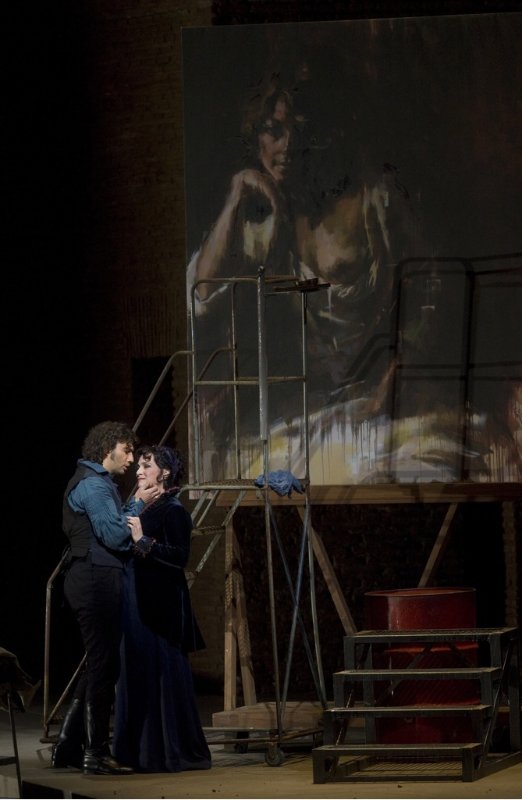|
|
|
|
|
|
|
|
| Interview Magazine, April 20, 2010 |
| By Alex Gartenfeld |
| |
| Tosca, Metropolitan Opera, 14. April 2010 |
| |
Revenge of the Booed Opera
|
 There is no redemption in the Napoleonic era in which Puccini's Tosca
is set. None of the main characters, with the significant exception of
the villainous tyrant Scarpia, could be said to have earned his or her
murder by deceit or suicide. This is not the experience of the Greek
hero and his insurmountable fatal flaw; the eponymous protagonist, a
singer, indulges in a bit of hysterical jealousy when she realizes that
her lover, the painter Cavaradossi, has painted the Madonna after the
sister of an escaped rebel. Cavarodossi, for his part, plays the
martyr, and the easy token victim to conservative repression of
Scarpia's repressive regime. There is no redemption in the Napoleonic era in which Puccini's Tosca
is set. None of the main characters, with the significant exception of
the villainous tyrant Scarpia, could be said to have earned his or her
murder by deceit or suicide. This is not the experience of the Greek
hero and his insurmountable fatal flaw; the eponymous protagonist, a
singer, indulges in a bit of hysterical jealousy when she realizes that
her lover, the painter Cavaradossi, has painted the Madonna after the
sister of an escaped rebel. Cavarodossi, for his part, plays the
martyr, and the easy token victim to conservative repression of
Scarpia's repressive regime.
But there was redemption Wednesday and Friday night in director
Luc Bondy's production of Tosca, a piece that was booed when it
premiered almost a year ago. The show was roundly compared it to the
storied production by Italian director Franco Zeffirelli, with Maria
Callas in the lead part. (Zeffrielli, for his part, called Bondy a
"third-rate" director for turning Puccini's opera into a darker, more
minimal affair).
On Wednesday, Bondy set out with a new cast:
Patricia Racette, in the role opera buffs (and all they do is polish)
remember as belonging to Maria Callas. Racette is irascible and
inexplicable with jealousy, and then melodramatically appeased in the
first act. She's tragic in the last, as her attempts to defend her
lover's honor, her honor, and then his life, are in vain. Although the
script calls for vast changes in temperament, Racette's style never
feels episodic. She carries the lyrical arias in the second act, and
her voice grows as the show goes on, pleading for Cavaradossi's release
as he refuses to give up the location of the hidden rebel. Racette's a
wise choice to supplement the public memory of Tosca because, like
Callas, who could go dramatically flat, her's is an idiosyncratic
voice. She's gravelly and her pacing is wild in the beginning, but
unfolds and ultimately demonstrates control.
Jonas Kaufmann is
rare for a German tenor–he’s smolderingly handsome. He's also
remarkably fluid as the strong-willed bohemian who sticks to his guns
but can't save himself–and maybe, just maybe will find vindication when
Napoleon defeats Scarpia. His voice soaring over the orchestra in the
first act was particularly remarkable. Bryn Terfel finds humor as the
relentless Scarpia; he uses his strong baritone to overpower and seduce.
There
are repeated complaints about the interpretation of staging, which are
not, in fact, distracting. Cavaradossi's painting of the Madeleine with
her breast exposed is onstage throughout; it's a sordid altarpiece in
an opera with equally sordid motives. The booed production involved
characters embracing this image; she's only cut, here, across the eyes
by Tosa, her innocence already lost. Thankfully, the production lacked
the rising and falling sets and mysterious nooks that the Met so often
favors. The second act, set in Scarpia's chambers, the setting of the
second act, was a wonderfully bizarre period room, which looked like an
administrative post office designed by Frank Stella in the 1970s. It
was as fully and obscurely realized, as an opera about unexplained
wrath ought to be."
|
|
|
|
|
|
|
|
|
|
|
|
|
|
|
|
|
|
|